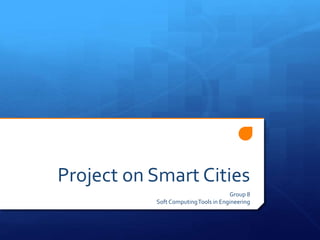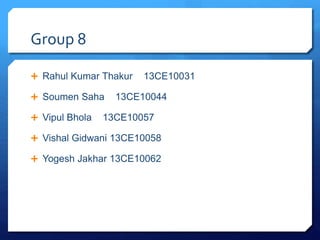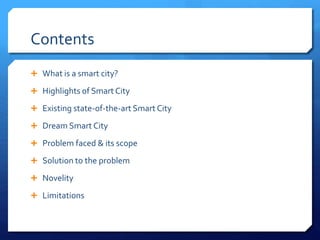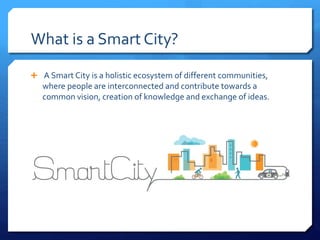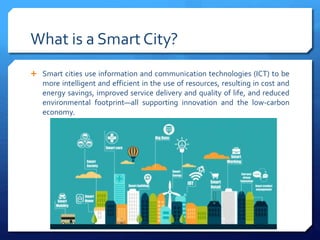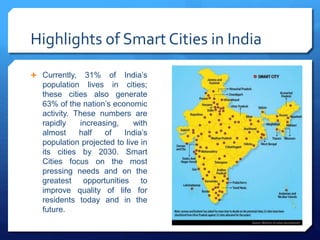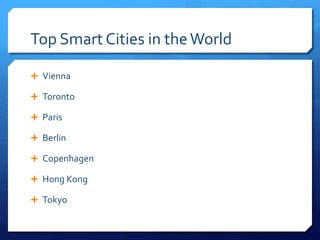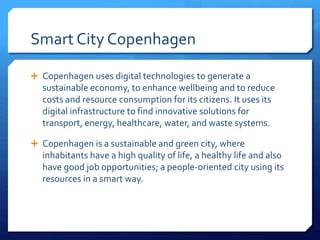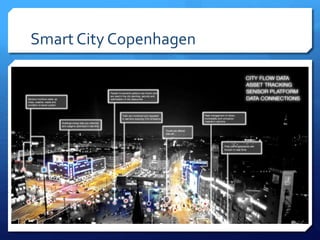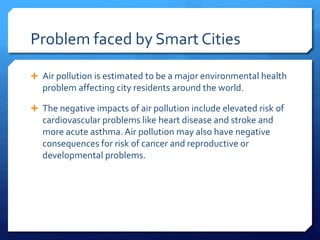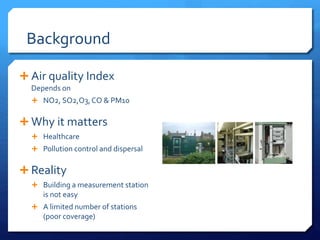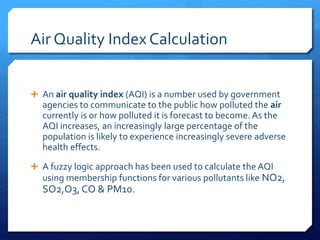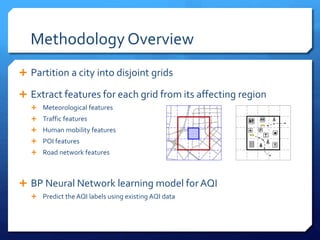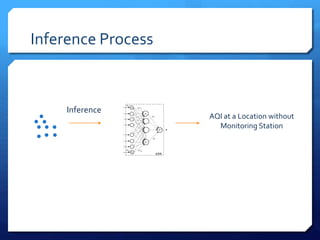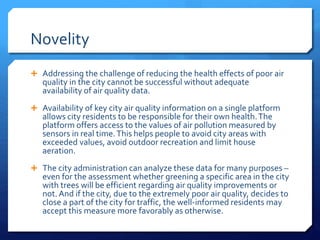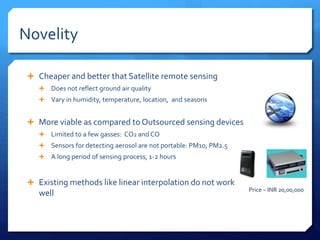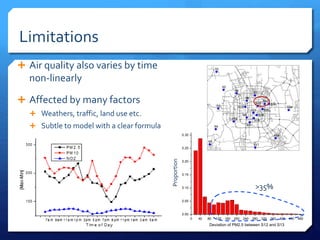Group-8-Project
- 1. Project on Smart Cities Group 8 Soft ComputingTools in Engineering
- 2. Group 8 ’āŖ Rahul Kumar Thakur 13CE10031 ’āŖ Soumen Saha 13CE10044 ’āŖ Vipul Bhola 13CE10057 ’āŖ Vishal Gidwani 13CE10058 ’āŖ Yogesh Jakhar 13CE10062
- 3. Contents ’āŖ What is a smart city? ’āŖ Highlights of Smart City ’āŖ Existing state-of-the-art Smart City ’āŖ Dream Smart City ’āŖ Problem faced & its scope ’āŖ Solution to the problem ’āŖ Novelity ’āŖ Limitations
- 4. ’āŖ A Smart City is a holistic ecosystem of different communities, where people are interconnected and contribute towards a common vision, creation of knowledge and exchange of ideas. What is a Smart City?
- 5. What is a Smart City? ’āŖ Smart cities use information and communication technologies (ICT) to be more intelligent and efficient in the use of resources, resulting in cost and energy savings, improved service delivery and quality of life, and reduced environmental footprintŌĆöall supporting innovation and the low-carbon economy.
- 6. Key aspects of Smart Cities ’āŖ a modern digital infrastructure ’āŖ a recognition that service delivery is improved by being citizen centric ’āŖ an intelligent physical infrastructure ’āŖ an openness to experiment with new approaches ’āŖ transparency of outcomes/performance
- 7. Highlights of Smart Cities in India ’āŖ Currently, 31% of IndiaŌĆÖs population lives in cities; these cities also generate 63% of the nationŌĆÖs economic activity. These numbers are rapidly increasing, with almost half of IndiaŌĆÖs population projected to live in its cities by 2030. Smart Cities focus on the most pressing needs and on the greatest opportunities to improve quality of life for residents today and in the future.
- 8. Top Smart Cities in theWorld ’āŖ Vienna ’āŖ Toronto ’āŖ Paris ’āŖ Berlin ’āŖ Copenhagen ’āŖ Hong Kong ’āŖ Tokyo
- 9. Smart City Copenhagen ’āŖ Copenhagen uses digital technologies to generate a sustainable economy, to enhance wellbeing and to reduce costs and resource consumption for its citizens. It uses its digital infrastructure to find innovative solutions for transport, energy, healthcare, water, and waste systems. ’āŖ Copenhagen is a sustainable and green city, where inhabitants have a high quality of life, a healthy life and also have good job opportunities; a people-oriented city using its resources in a smart way.
- 10. Smart City Copenhagen ’āŖ CopenhagenŌĆÖs number one initiative is to achieve carbon dioxide neutrality. It will be the first capital in the world to become CO2 neutral by 2025. In achieving this goal, Copenhagen is looking into the energy management of buildings, traffic issues, and fuel and energy consumption. ’āŖ Huge investments have been made into cycling and public transportation. Specialized lighting and GPS and wireless systems will fully support the biking transition.These systems can even calculate the amount of money being saved.
- 12. Dream Smart City
- 13. Problem faced by Smart Cities ’āŖ Air pollution is estimated to be a major environmental health problem affecting city residents around the world. ’āŖ The negative impacts of air pollution include elevated risk of cardiovascular problems like heart disease and stroke and more acute asthma. Air pollution may also have negative consequences for risk of cancer and reproductive or developmental problems.
- 14. Problem Statement ’āŖ Air Quality Monitoring using Soft ComputingTools
- 15. Scope ’āŖ Many countries are suffering from air pollutions. Many cities have built a few air quality monitoring stations to inform people about urban air quality every hour. Influenced by multiple complex factors, however, urban air quality is highly skewed in a city, varying by locations significantly and changing over time differently in different places. ’āŖ Thus, we do not know the air quality of a location without a monitoring station.We do not know what the air quality at a place will be tomorrow either, let alone the root cause the air pollution.
- 16. Background ’āŖ Air quality Index Depends on ’āŖ NO2, SO2,O3,CO & PM10 ’āŖ Why it matters ’āŖ Healthcare ’āŖ Pollution control and dispersal ’āŖ Reality ’āŖ Building a measurement station is not easy ’āŖ A limited number of stations (poor coverage)
- 17. Air Quality Index Calculation ’āŖ An air quality index (AQI) is a number used by government agencies to communicate to the public how polluted the air currently is or how polluted it is forecast to become. As the AQI increases, an increasingly large percentage of the population is likely to experience increasingly severe adverse health effects. ’āŖ A fuzzy logic approach has been used to calculate the AQI using membership functions for various pollutants like NO2, SO2,O3, CO & PM10.
- 18. Break Point Concentrations And AQIValues
- 19. Effects of varying air quality
- 20. Factors affecting Air Quality Meteorology Traffic POIs Road networksHuman Mobility Historical air quality data Real-time air quality reports
- 21. Methodology Overview ’āŖ Partition a city into disjoint grids ’āŖ Extract features for each grid from its affecting region ’āŖ Meteorological features ’āŖ Traffic features ’āŖ Human mobility features ’āŖ POI features ’āŖ Road network features ’āŖ BP Neural Network learning model forAQI ’āŖ Predict the AQI labels using existing AQI data
- 22. Learning Process Training Labeled AQI Data Unlabeled AQI Data Inference ŌłåP1x ŌłåR1x c D1Fp Fr l1 D2 c d1x D1 D2 D1 D1 1 1 Fp Fr lk k k Fp x Fr x lx ŌłåPkx ŌłåRkx c dkx 1 k x ANNInput generation w'11 w'qr w1 wr wpq w11 b1 bq b'r b'1 b''
- 23. Inference Process ŌłåP1x ŌłåR1x c D1Fp Fr l1 D2 c d1x D1 D2 D1 D1 1 1 Fp Fr lk k k Fp x Fr x lx ŌłåPkx ŌłåRkx c dkx 1 k x ANNInput generation w'11 w'qr w1 wr wpq w11 b1 bq b'r b'1 b'' Inference AQI at a Location without Monitoring Station
- 24. Application ’āŖ Urban air quality is of great importance in protecting human health. While there are limited air-quality-monitor-stations in a city, air quality varies by location significantly and is influenced by multiple complex factors, such as traffic flow and land use. Consequently, people cannot know the air quality of a location without a monitoring station. ’āŖ This project infers air-quality information throughout a city, based on air-quality data reported by existing monitor stations and a variety of data sources observed in the city, such as meteorology, traffic flow, human mobility, the structure of road networks, and points of interest. ’āŖ This air-quality information could help people figure out when and where to go joggingŌĆöor when they should shut the window or put on a face mask in locations where air quality is already a daily issue. ’āŖ Staff, working with the most vulnerable population, such as children, elderly, and sick people, can use these data to appropriately assess whether to ventilate the rooms, lead the children for a walk or onto the playground, and the like.
- 25. Novelity ’āŖ Addressing the challenge of reducing the health effects of poor air quality in the city cannot be successful without adequate availability of air quality data. ’āŖ Availability of key city air quality information on a single platform allows city residents to be responsible for their own health.The platform offers access to the values of air pollution measured by sensors in real time.This helps people to avoid city areas with exceeded values, avoid outdoor recreation and limit house aeration. ’āŖ The city administration can analyze these data for many purposes ŌĆō even for the assessment whether greening a specific area in the city with trees will be efficient regarding air quality improvements or not.And if the city, due to the extremely poor air quality, decides to close a part of the city for traffic, the well-informed residents may accept this measure more favorably as otherwise.
- 26. Novelity ’āŖ Cheaper and better that Satellite remote sensing ’āŖ Does not reflect ground air quality ’āŖ Vary in humidity, temperature, location, and seasons ’āŖ More viable as compared to Outsourced sensing devices ’āŖ Limited to a few gasses: CO2 and CO ’āŖ Sensors for detecting aerosol are not portable: PM10, PM2.5 ’āŖ A long period of sensing process, 1-2 hours ’āŖ Existing methods like linear interpolation do not work well Price ~ INR 20,00,000
- 27. Limitations ’āŖ Air quality also varies by time non-linearly ’āŖ Affected by many factors ’āŖ Weathers, traffic, land use etc. ’āŖ Subtle to model with a clear formula 0 40 80 120 160 200 240 280 320 360 400 440 480 0.00 0.05 0.10 0.15 0.20 0.25 0.30 Portition Deviation of PM2.5 between S12 and S13 >35% Proportion A) Beijing (8/24/2012 - 3/8/2013)
- 28. ThankYou Group 8: Rahul Kumar Thakur 13CE10031 Soumen Saha 13CE10044 Vipul Bhola 13CE10057 Vishal Gidwani 13CE10058 Yogesh Jakhar 13CE10062
Editor's Notes
- #7: a modern digital infrastructure, combined with a secure but open access approach to public re-useable data, which enables citizens to access the information they need, when they need it; a recognition that service delivery is improved by being citizen centric: this involves placing the citizenŌĆÖs needs at the forefront, sharing management information to provide a coherent service, rather than operating in a multiplicity of service silos (for example, sharing changes of address more effectively), and offering internet service delivery where possible (at a fraction of the face to face cost); an intelligent physical infrastructure (ŌĆ£smartŌĆØ systems or the Internet of Things), to enable service providers to use the full range of data both to manage service delivery on a daily basis and to inform strategic investment in the city/community (for example, gathering and analysing data on whether public transport is adequate to cope with rush hour peaks); an openness to learn from others and experiment with new approaches and new business models; and transparency of outcomes/performance, for example, city service dashboards to enable citizens to compare and challenge performance, establishment by establishment, and borough by borough.
- #13: But the concept is not static: there is no absolute definition of a dream smart city, no end point, but rather a process, or series of steps, by which cities become more ŌĆ£liveableŌĆØ and resilient and, hence, able to respond quicker to new challenges. Thus, a Smart City should enable every citizen to engage with all the services on offer, public as well as private, in a way best suited to his or her needs. It brings together hard infrastructure, social capital including local skills and community institutions, and (digital) technologies to fuel sustainable economic development and provide an attractive environment for all.
- #21: Finer granularity inference

